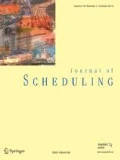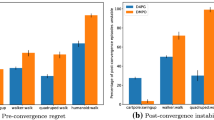Abstract
Schedulers' decisions in real factories deal with perceived risks and impacts. They proactively anticipate and reactively mitigate risky events by altering what would be considered a normal schedule to minimize associated impacts. These risk mitigation concepts are called aversion dynamics (AD). Aversion dynamics describes the aversion that jobs exhibit to impacts resulting from risky events in dynamic and unstable production environments. The aversion manifests itself in either advancing or delaying the work to avoid the risky period. This paper extends the first AD heuristic, Averse-1, to capture additional real-world dynamics and to make the heuristic predictive (proactive) as to when the perceived risky event may happen. In particular, predictive and stochastic elements are incorporated within a dynamic job arrival framework to create an extended heuristic called Averse-2.
Similar content being viewed by others
REFERENCES
McKay, K. N., T. E. Morton, P. Ramnath, and J. Wang, “Aversion dynamics scheduling when the system changes,” J. Sched., 3, 71–88 (2000).
McKay, K. N., Production Planning and Scheduling: A Model for Manufacturing Decisions Requiring Judgement, Ph.D. Dissertation, Department of Management Sciences, University of Waterloo, 1992.
McKay, K. N., F. R. Safayeni, and J. A. Buzacott, “Common sense realities of planning and scheduling in printed circuit board production,” Int. J. Prod. Res., 33, 1587–1603 (1995).
McKay, K. N., J. A. Buzacott, N. Charness, and F. R. Safayeni, “The scheduler's predictive expertise: An interdisciplinary perspective,” in G. I. Doukidis, and R. J. Paul (eds), Artificial Intelligence in Operational Research — Journal of the Operational Research Society, Macmillan Press, London, 1992, pp. 139–150.
Baker, K. R. (ed.), Introduction to Sequencing and Scheduling, New York, John Wiley, 1974.
Gittins, J. C., “Bandit processes and dynamic allocation indices,” J. R. Stat. Soc., Series B, 41(2), 148–177 (1979).
Glazebrook, K. D., “Stochastic scheduling with order constraints,” Int. J. Sys. Sci., 7, 657–666 (1976).
Glazebrook, K. D., “Scheduling stochastic jobs on a single machine subject to breakdowns,” Naval Logistics Quarterly, 31, 251–264 (1984).
Wu, S. D. and R. H. Storer, “A Rescheduling Procedure for Manufacturing Systems Under Random Disruptions,” New Directions for Operations Research in Manufacturing Conference Proceedings, Gaithersburg, Maryland, 1991, pp. 292–306.
Wu, S. D., R. H. Storer, and P. Chang, “One-Machine Rescheduling Heuristics With Efficiency and Stability as Criteria,” Comput. Oper. Res., 20(1), 1–14 (1993).
O'Donovan, R., Predictable Scheduling and Aversion Dynamics for a Single Machine, Master's Thesis, Department of Industrial Engineering, Purdue University, 1997.
O'Donovan, R., Uzsoy, R., and McKay, K. N., “Predictable scheduling of a single machine with breakdowns and sensitive Jobs,” Int. J. Prod. Res., 37(18), 4217–4233 (1999).
Morton, T. E. and R. M. Rachamadugu, “Myopic heuristics for the single machine weighted tardiness problem,” Technical Report CMU-RI-TR-83-9, Graduate School of Industrial Administration, Carnegie-Mellon University, 1983.
Morton, T. E. and P. Ramnath, “Guided forward search in tardiness scheduling of large one machine problems,” Working Paper 1992-52, Graduate School of Industrial Administration, Carnegie-Mellon University, 1992.
Narayan, V., T. E. Morton, and P. Ramnath, “X-Dispatch Methods for Weighted Tardiness Job Shops,” Working Paper 1994-14, Graduate School of Industrial Administration, Carnegie-Mellon University, 1994.
Morton, T. E., “Bottleneck dynamics-a heuristic scheduling framework,” Working Paper, Carnegie-Mellon University, 1993.
Morton, T. E., V. Narayan, and P. Ramnath, “A tutorial on bottleneck dynamics: a heuristic scheduling methodology,” Prod. Oper. Manag., 4(2), 94–107 (1995).
Morton, T. E. and D. W. Pentico, Heuristic Scheduling Systems, John Wiley, New York, 1993.
Mehta, S. V. and R. Uzsoy, “Predictable scheduling to reduce effects of disruptions on production schedules,” INFORMS Conference Proceedings, New Orleans, Louisiana, 1995.
Mehta, S. V. and R. Uzsoy, “Predictable scheduling of a job shop subject to breakdowns,” IEEE Trans. on Robotics and Automation, 14(3), 365–378 (1998).
Mehta, S. V. and R. Uzsoy, “Predictable scheduling of a single machine subject to breakdowns,” Int. J. Comp.Integ. M., 12(1), 15–38 (1999).
Author information
Authors and Affiliations
Corresponding author
Rights and permissions
About this article
Cite this article
Black, G.W., McKay, K.N. & Messimer, S.L. Predictive, Stochastic and Dynamic Extensions to Aversion Dynamics Scheduling. Journal of Scheduling 7, 277–292 (2004). https://doi.org/10.1023/B:JOSH.0000031422.02125.97
Issue Date:
DOI: https://doi.org/10.1023/B:JOSH.0000031422.02125.97




